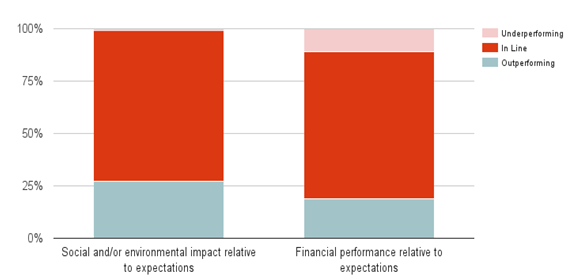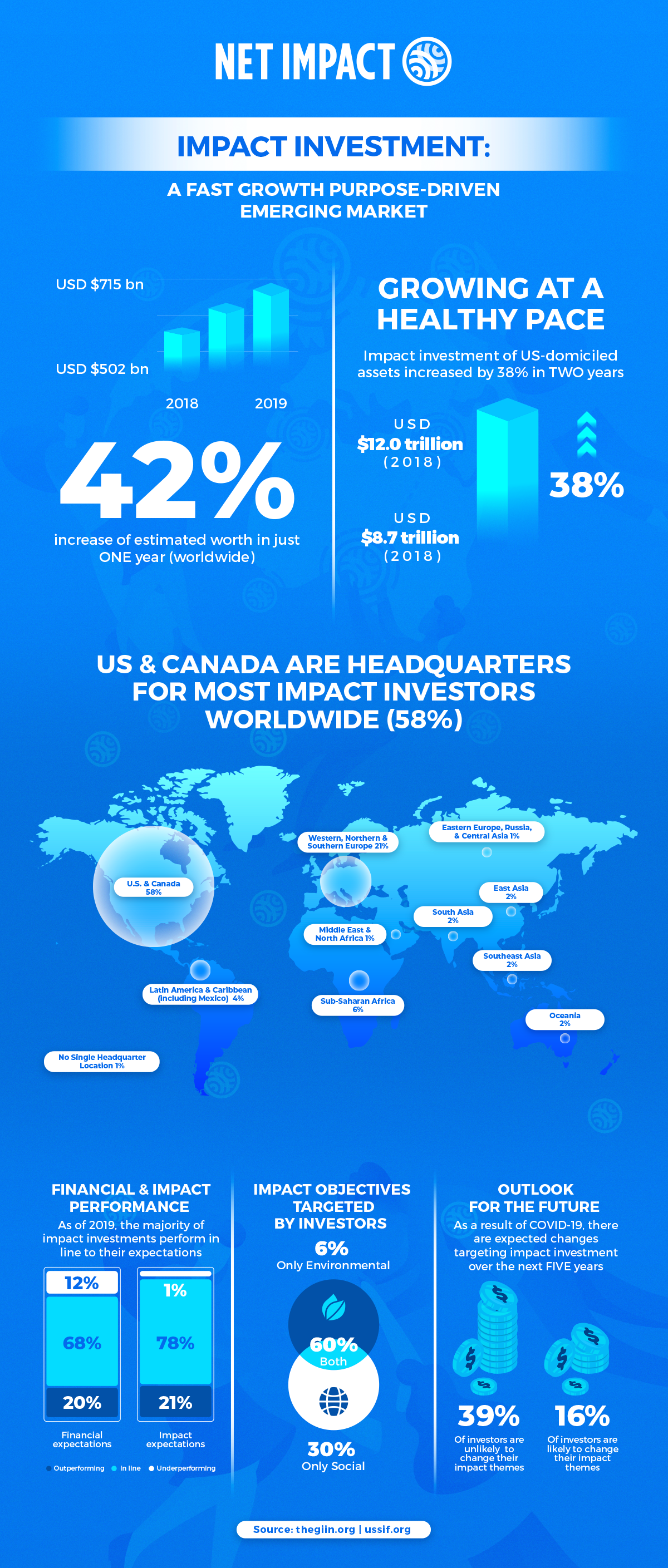1. Impact Investing Fundamentals

Every day, the world faces hunger, inadequate healthcare, unsafe water, inequality, and challenges associated with climate change and a lack of natural resources.
What is Impact Investing?
Impact investing is using capital to make a social or environmental impact. In addition to making financial returns on investment, impact investors look at how they can make a difference in the world through finances, business ventures, and projects. Impact investing can cover a wide array of topics from sustainability in agriculture, to reducing carbon footprints with technology, to advocating for job security and financial literacy. You can be an impact investor in whatever interests you - there are a multitude of different social and environmental issues impacting the world today that can be addressed through impact investing.
Who’s going to solve these challenges?
Impact investing serves as a new investment strategy within many different companies, organizations, and funds -- nonprofit and for-profit -- with the intention to generate positive social and/or environmental impact.
2. The Impact Investing Spectrum
Impact investments generate social and/or environmental impact, as well as some expectation of a return of- and/or on invested capital.
Impact investors vary in their financial return expectations. While some seek competitive or market-rate returns, others may be willing to accept below market-rate returns to maximize impact.
The Impact Investment (Financial Return) Spectrum:

-
Philanthropy
-
Grants that have an anticipation of generating social and/or environmental impact with no expectation of any return on capital
-
-
Program-Related Investing (PRI)
-
Investments made for the primary objective of achieving a social and/or environmental impact, with an expectation of a partial or full return of capital, and/or a limited return on the investment
-
-
Impact First Investing
-
Investments that are willing to accept a lesser financial outcome -- either taking greater risks or accepting lower returns-- in order to achieve social and/or environmental impact
-
-
Market-Rate Impact Investing
-
Investments that seek a full market-rate return, AND some measurable beneficial social and/or environmental impact
-
-
Mainstream Investing
-
Investing with an expectation of a full market-rate return, but no beneficial impact
-
The universe of impact investing comes under the heading of many new terms: “socially responsible investing,” “sustainable investing”, “thematic investing”, “impact first”, and “double or triple bottom lines”, among others.
This spectrum of impact investing approaches can help differentiate between some of these types of investing based on their social/environmental impact:
- Philanthropy: Fully oriented to positive social and/or environmental impact
- Thematic Investing: Investments in thematic sectors that provide an explicit social and/or environmental benefit
- Sustainable Investing (ESG): Uses a positive investment screen to include environmental, social, and governance (ESG) consideration of companies that aims to generate a positive social and/or environmental impact, rather than just negative impact avoidance
- Socially Responsible Investing (SRI): While SRI integrates social and environmental factors in investment analysis, negative screening is a relatively passive strategy that ensures no negative impacts on society and/or the environment, but does not necessarily add to any positive outcomes
- Mainstream Investing: Investing in companies that have no consideration of beneficial social or environmental impact

3. Impact Sectors
Impact investing is based around two impact sectors: social and environmental.
- The social impact sector can range anywhere from healthcare, microfinance, food security, power, and housing.
- The environmental impact sector is based on the challenges that come with climate change, including: resource scarcity and conservation, energy efficiency, clean water, sustainable agriculture, food, and timber.

4. Why Impact Investing?
To solve global challenges:
- Social
- Environmental
Opportunities:
Millennials:
46% of Millennials stated that they have ambitions to make a positive impact on their communities and society. 29% of investors in their 20s and 30s look for financial advisors that will help them to pursue value-based investments, and millennials are twice as likely to invest in companies or funds with social and environmental goals and outcomes.
Major transfers of generational wealth
It is estimated that as much as $68 trillion will be moved from the baby boomer generation to the younger Generation X and Millennial generations. This puts the future of investments in the hands of the younger generation, who are interested in pursuing ventures that will make a social or environmental impact.
Investors:
Institutions, individuals, foundations, pension funds, endowments, etc. aligning their investment capital with the ideals that they stand for.
Capital invested in impact investments:

GIIN, the Global Impact Investing Network, estimated the current market size of impact investing to be $715 billion. Over 1,720 organizations manage funds that go towards impact investments.
Consumers:
Increasing consumer demand for environmental and/or socially oriented products and services. 8 in 10 consumers indicated sustainability as being an important factor in their buying decisions. 57% of consumers were willing to change their habits based on sustainability. 25% of all investments in the United States go towards ESG companies.
*** ESG: environmental, social, and governance consideration of companies
5. Impact Investing Sectors
While private equity offers the greatest opportunity for beneficial social and/or environmental impacts, impact investment opportunities exist across all asset classes.
-
Fixed Income:
- Fixed income investments are focused on the preservation of capital and income. These include invesments such as government and corporate bonds, as well as money market funds. Its
- Green Bonds include infrastructure bonds, conservation-based financing, and muni bonds.Learn more about Muni Bonds.
- Social Finance Bonds includes Pay for Success. Learn more about Pay for Success.
- Fixed income investments are focused on the preservation of capital and income. These include invesments such as government and corporate bonds, as well as money market funds. Its
-
Public Equities:
- Public equities give investors a share of the business. They are typically paid through stock accumulation, and are advantageous because of liquidity and the fact that they are usually more readily available for investors.
- ESG
- Thematic
- Shareholder Activism
- Public equities give investors a share of the business. They are typically paid through stock accumulation, and are advantageous because of liquidity and the fact that they are usually more readily available for investors.
-
Alternatives:
-
Credit investment is debt that is issued to investors; this includes notes and securitized obligations. . Hedge strategies are risk management strategies that offset investment loss by making a trade in a separate investment. Oftentimes these two investments have negative correlation.
- Credit, including project financing for social and/or environmental development
- Hedge Strategies
-
-
Real Assets:
- Real assets include real estate, infrastructure, and commodities such as resources and basic goods. The worth of these assets come from their substance and physical properties.
- Renewable energy
- Sustainable agriculture and timber
- Water
- Green real estate
- Real assets include real estate, infrastructure, and commodities such as resources and basic goods. The worth of these assets come from their substance and physical properties.
-
Private Equity:
- Private equity investors are paid through distributions; these are paid throughout the life of the investment.
- Social Entrepreneurship
- Seed Capital
- Venture Capital
- Buyout
- Includes investing in: healthcare, green technology, sustainable agriculture, housing, clean water and conservation, inclusionary financing, etc.
- Private equity investors are paid through distributions; these are paid throughout the life of the investment.
6. Impact Performance
Impact investments can produce market-rate returns alongside long-term positive impact.
Reports show that portfolio performance meets or exceeds investor expectations for both social and/or environmental impact and financial return.
Impact and Financial Performance Relative to Expectations

Financial Returns
How an investment performs financially varies based on the investor’s capabilities and objectives.
The Impact Investing Benchmark, an analysis of the financial performance of 51 impact-focused private equity and venture capital funds launched between 1998 and 2010, demonstrates that impact investments are capable of producing internal rates of return (IRR) equal to, and at times better than, traditional investments of comparable size and geography. The Report was produced by the Global Impact Investing Network and Cambridge Associates. As the first comprehensive analysis of the financial performance of impact investing funds, the Impact Investing Benchmark represents the first of many steps in understanding industry performance of impact investing. The Benchmark is part of the growing evidence for impact investments as a competitive financial product, working against the misconception that impact investments must sacrifice financial return in order to achieve social return.
Impact Measures
Measuring the social and/or environmental impact also varies based on the objectives and strategies of the investment.
Different indicators determine environmental and social impact and help to demonstrate a net benefit to society.
Three of the top questions to consider when evaluating a company are:
1. How do companies value employees?
2. How is sustainability integrated into decision-making?
3. How efficiently are companies using natural resources?
Companies that demonstrate an integration of sustainability principles and practices into operating metrics are considered to be high impact to both individual and institutional investors. Knowable, public indicators provide information that allows both impact investors and conscious consumers to know that sustainability is part of the whole company, not just a sum of its parts.
Still, given the limited sample of investments, varied ways of measuring, and the overall newness of the market, additional research and an industry-wide accepted measurement will be necessary to draw conclusive results.
7. Challenges of Impact Investing
-
Definition/Terminology
- With an effort to make a difference, there are different paths that a person can take. It can be difficult to assess whether something falls under socially responsible investing or impact investing.
-
Funding
- There is a lack of mobilization from the private sector, and many funds are too small for mainstream investors.
-
Consistent Metrics
-
There are a wide variety of different investments that an investor can pursue; this creates discrepancies and inconsistencies in how success can be measured. SDGs are commonly looked at for measurements.
-
-
Limited Demonstrated Results
- As impact investing is becoming more popular, there are greater opportunities to see the results from impact investments. With this, it is important to understand the value of investments.
-
Startup Risk
- Some of the risks associated with startups include principal risk, returns risk, returns delay, and liquidity risk.
Learn more about challenges faced by the Chan Zuckerberg Initiative.
8. Who is involved in impact investing?
-
Financial Institutions
- Pension funds, banks, insurance companies
- Corporate and public, domestic and international (developed and emerging)
-
Private Foundations
-
Sovereign Wealth Funds
-
Development Finance Institutions (DFIs)
-
Public Agencies
-
Individual Investors
9. Examples of Impact Investing
Gender Lens Investing
Gender lens investing is investing that considers the benefits to women and girls, ranging from promoting gender equality and women’s empowerment in the U.S., to providing clean-burning stoves to women in Africa.
Gender lens investing will continue to be one of the most important types of impact investing. Companies with more women board directors outperform their male counterparts, and women tend to invest in areas that improve human wellbeing, such as maternal mortality, clean water, safe cook stoves, and children’s education- bringing accelerated social impact.
Food and Animal Investing
Some of the biggest investment institutions such as Bank of America and Morgan Stanley have joined with NGOS and leading food companies to discuss how their portfolios could impact the food industry.
Only several years ago, animal welfare in companies was rarely considered to investors, and if the issue did come up was likely only featured occasionally on negative screening lists for specific ethics-based investors.
Recently, farm standards have been seen as a rising business risk to companies looking to invest, not only for the welfare of the animals, but for the environment, human health pandemics such as the swine flu, and the withering company value.
The term cruelty-free investing is investing in companies that do not support animal exploitation or cause any harm to animals. Cruelty-free investing options have become and will continue to be increasingly more available in the next few years as consumers and companies become more concerned with both the environmental and ethical issues surrounding animal exploitation.
10. How to start your impact investing journey
There are a number of ways to get involved with impact investing. Check out how you can get started in the sector today.
Supported by the John D. and Catherine T. MacArthur Foundation


